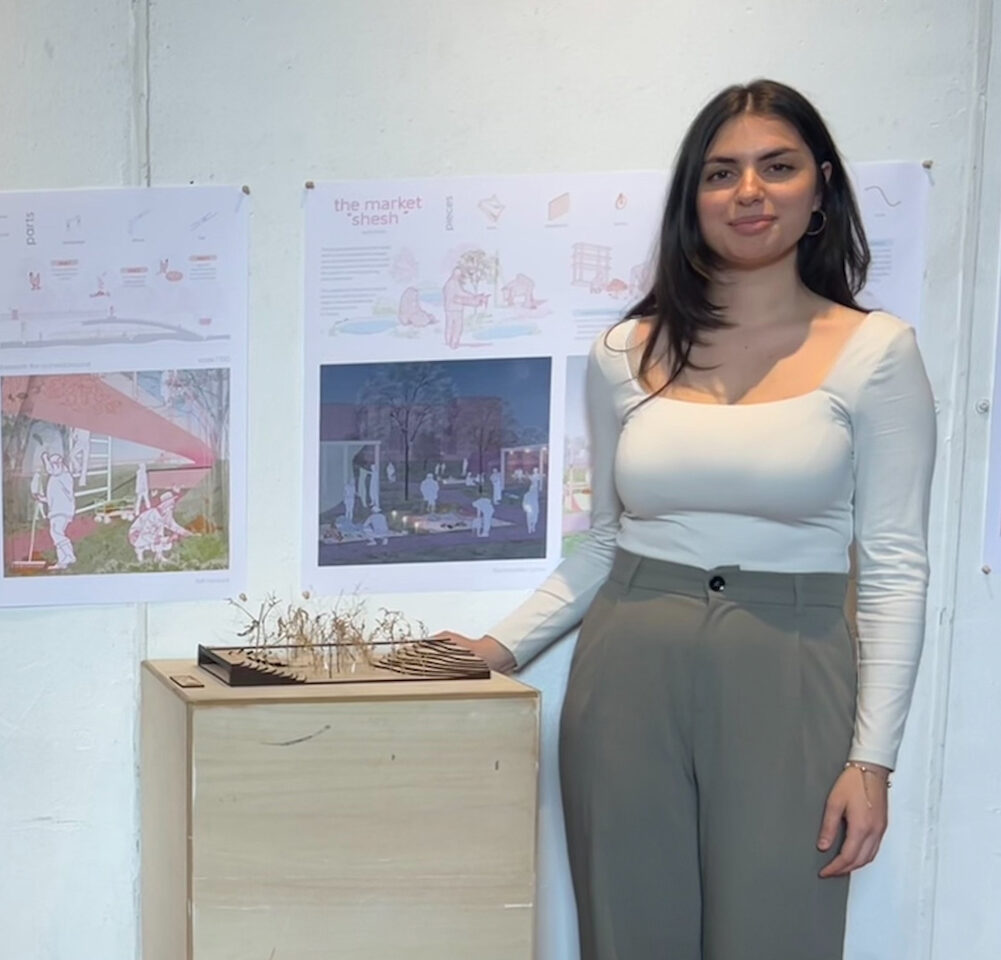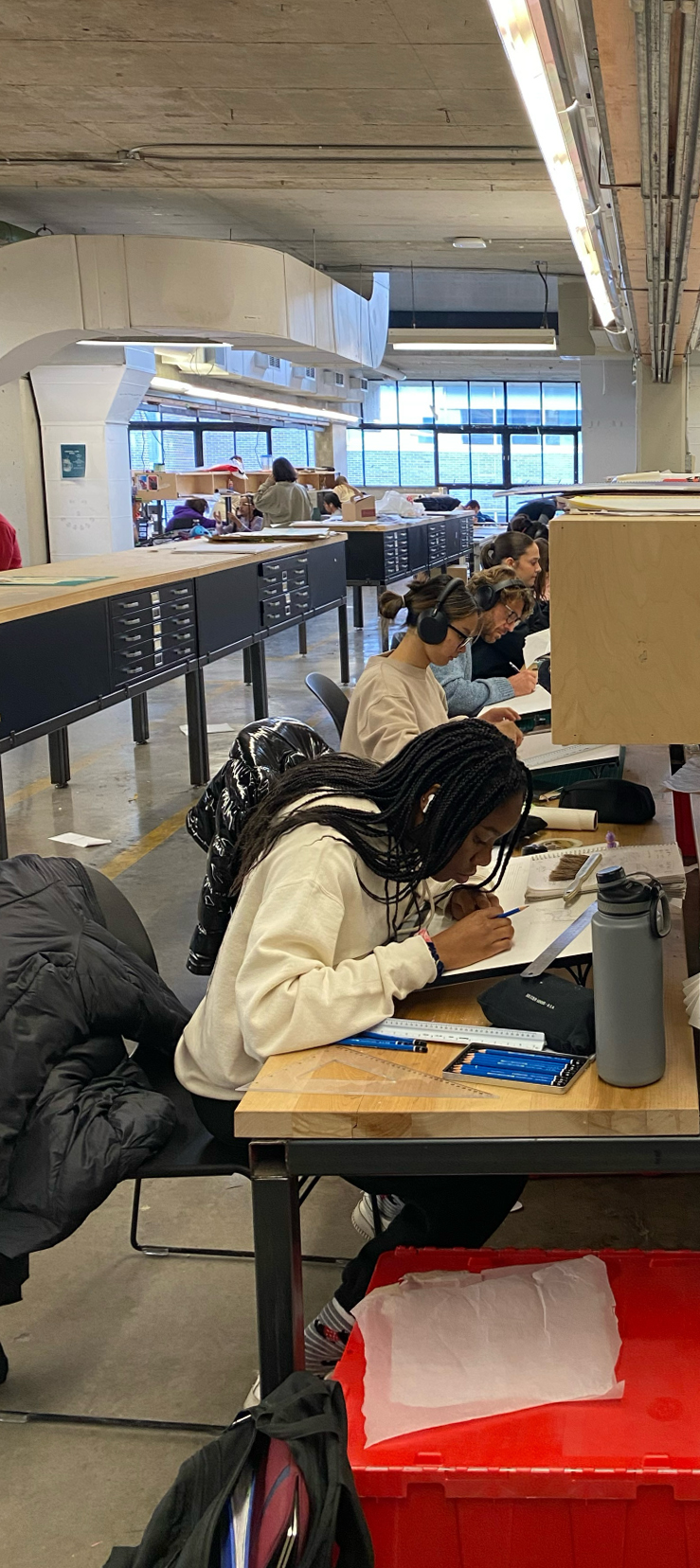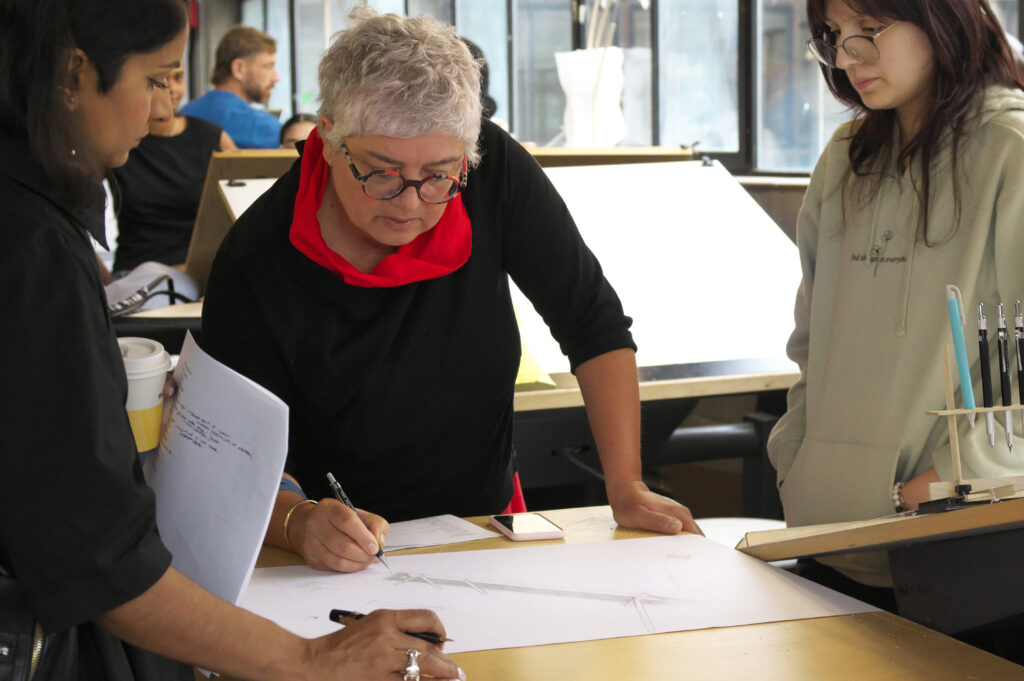Introducing a New Undergraduate Curriculum
June 30, 2025
By Maria Cook
Julianna Avramidis, who is entering the fourth year of the Bachelor of Architectural Studies (BAS) program in September, says she is having an “absolutely wonderful” experience. She was drawn to Carleton University’s architecture school because it offered a major in Urbanism and “because of its culture to encourage students to engage with broader social, cultural, and environmental questions through design.”

The undergraduate architectural program at Carleton is unique among Canadian schools in offering three streams of study. Incoming students may choose to major in Urbanism, Conservation & Sustainability, or Design.
Starting this fall, the school is introducing a new curriculum for the incoming first-year BAS students, about 95 of them. The changes are structural and philosophical.
“The school is working to instill in our future designers a lively awareness of a shared planet,” explains Director Anne Bordeleau. “To that end, we are transitioning our curriculum so that it begins with land and building relationships, and moves through broad ecosystems, the public realm, and existing built environments.”
For example, beginning with land as a theme in the first year emphasizes climate, Indigenous knowledge, and global interconnectedness, says Dr. Bordeleau.
“Throughout, our teachings consider adaptive architecture, urbanism, and climate as integral to any design,” she says.
In the 2024-25 school year, there were 430 undergraduates across the four years: 300 in Design, 67 in Urbanism, and 63 in Conservation & Sustainability.

Until now, the groups have focused on their specialization. Going forward, the three streams will share more studios. The shift recognizes the importance for all students to be knowledgeable in sustainability, sensitive to the adaptive reuse of existing buildings, and able to work collaboratively to make livable urban spaces.
In addition, all three undergraduate streams will meet the requirements of the Canadian Architectural Certification Board (CACB) for pre-professional degrees. This means all students will be eligible for a two-year Master of Architecture professional program. Until now, students in Conservation & Sustainability and Urbanism were required to do an additional year of graduate studies to make up a shortfall in design studio time.
During consultations, students expressed a strong wish for a consistent path to professional qualification and a cohesive learning experience.
“The biggest thing for me has been wanting to engage with bachelor’s students from other majors and even years,” says Avramidis, 26, who served as the Urbanism representative on the Azrieli Architecture Students Association (AASA).
“I’ve often noticed the differences in studio structure and time compared to the Design stream,” she says. “Our urbanism studio projects deal with complex social systems and larger contexts. Having more studio time would have given us more space to test ideas and refine our approach.
“It feels like this is a step toward greater cohesion and equity across the school.”
Associate Professor Johan Voordouw, who served as Associate Director, Undergraduate from 2019 to 2025, was instrumental in initiating and guiding conversations about restructuring. Together with Associate Professor Piper Bernbaum, who chaired the Curriculum and Teaching Committee, he played an important role in consolidating and shaping the revised curricula.

Students will benefit from having “a single, integrated Bachelor of Architectural Studies program where all students have equal opportunity for advancement to graduate studies,” says Voordouw.
“It replaces an already strong undergraduate curriculum, but the advantage is that now we have a core curriculum for all BAS students so they can apply to the two-year M.Arch,” he says.
Making these adjustments provides “the opportunity to assess in detail our different pedagogical arcs: studio, technology, history, theory, and technique courses and to align our electives more closely with our program,” he adds.
Associate Professor Janine Debanné is conscious of the school’s history and how deeply associated it is with the building, which centres the studio experience. “In some ways, the new program is a return to original patterns: studios every term for all students, for example.”
The shifts are an ongoing evolution of the school’s architecture program, which started in 1968 as a five-year professional program. In 1988, the school phased out its Bachelor of Architecture professional degree in favour of a four-plus-two (undergraduate and graduate) professional program.
In 2009, the school introduced the three majors at the undergraduate level. Unlike Design, Conservation & Sustainability and Urbanism were not originally conceived as pre-professional degrees, which affected their graduates’ future studies.
The school currently has two distinct paths toward a professional degree. The first is through a two-year Master of Architecture degree after a related pre-professional bachelor’s degree for a total of six years of study.
The second option is through a three-and-a-half-year Master of Architecture degree. It admits students who have a previous honour’s degree in any subject and has been the path for Conservation & Sustainability and Urbanism students.

Juan Ramirez, who holds a BAS in Urbanism and graduated this year with a Master of Architecture degree from Carleton, appreciated the extra year. “I found the additional year gave me valuable time to further refine my design skills and gain deeper insight into the kind of architect I aspire to be.”
The fact that students of the three-year program have diverse prior education and knowledge encourages exchange, which goes “far beyond the field of architecture,” he says.
That said, Ramirez, who represented graduate students at AASA, welcomes all streams becoming eligible for a two-year professional master’s degree.
“Based on my experience, some students who graduate from Urbanism or Conservation possess design skills and talent that are equal to or even more proficient than those of the Design stream students,” says Ramirez, 26.
“Therefore, some students feel discouraged from applying to the three-year program as they can take their talents straight to the workplace,” he says. “Likewise, they feel the inequity while in school.”
Associate Professor Mariana Esponda, who coordinates Conservation & Sustainability, agrees. “The students in Conservation felt like the ugly duckling, even though they are well-prepared and very employable.”
She welcomes the integration. “Everybody’s winning,” she says. “The students are going to be much better prepared. They are going to have a better understanding of the built environment. If you have existing buildings, you need to know how to deal with those, understand which values and histories are relevant to the community’s identity, and how we can foster them with contemporary uses, recycling materials instead of demolition. They’re going to have better skills on how to design and integrate new and old buildings.”
Conservation & Sustainability students will lose a couple of specialized technical courses, but they will gain more studio, which, she says, is ultimately more important.
Dr. Esponda sees the new curriculum as planting a seed of understanding. Being conscious of the histories of communities who have lived in a place, the meanings of land, and existing structures, will help students “reimagine what we can do for the future instead of just building new things.”

Natalie Murdoch, 22, had a clear wish to work with historic buildings and chose the Conservation & Sustainability stream. She completed her BAS in 2025 and will participate in the three-year M.Arch at Carleton starting this fall. She represented Conservation & Sustainability students at the student association.
“I have learned skills in a range of architectural subjects that have given me a well-rounded education, including architectural history, site documentation, engineering principles, conservation principles, and design skills.”
Murdoch suggests, however, that an extra year for a master’s may have deterred others from applying to Conservation or Urbanism. “Having an extra year of tuition payments and a delay in pursuing a full-time profession has put our specialized undergraduate program at a disadvantage when pursuing graduate studies,” she says.
“I agree that the curriculum could use improvements to balance the technical conservation courses with the design course,” she says. “It is important to bring up the studio hours to be on par with the design stream and equal eligibility for the two-year master’s program without losing the specialized nature.”
One of the drawbacks of the Conservation & Sustainability program, observes Murdoch, was “the hiatus from studio courses in the second year of the program, removing the opportunity to apply knowledge gained in other courses in a creative medium.”
Beginning this fall, there will be more shared classes, and joint studios will occur in all four years of the undergraduate program. Currently, the three majors are together only during the first year and part of the fourth year.
Associate Professor Benjamin Gianni, coordinator of the Urbanism program, explains that about 60 per cent of lectures will be common, with about 40 per cent specific to each specialization. Free choice of three electives remains, but the recalibration will involve more architectural classes.
Under the new curriculum, students in the three majors take core design studios in all three topic areas: building design, urban design, and sustainable adaptive reuse.
“I welcome these changes as they will produce more well-rounded graduates and facilitate greater interaction among our BAS cohort without sacrificing the specialized skills and knowledge we offer through each of the majors,” says Gianni.

Lauren Newell, 23, who graduated with a BAS this year in the Design stream, says that the sharing of studios only in the first- and fourth-year limited shared experience and friendships. Bringing the streams closer together will benefit the school as well as individual students.
“In the first year, we build strong connections with peers across all streams, but those connections often fade in the second and third years when our studios and physical spaces become more divided.”
George Gialouris-Tsivikas, who served as the undergraduate student representative on the student association, completed his BAS (Design) in 2025 and is now working at an architecture firm.
The design stream suited his aims when applying. It was a pre-professional program, and it offered a co-op experience. His ambitions were in contemporary design, not conservation.
The fact that the other streams were smaller, cohesive groups isolated on the fifth floor, while Design enjoyed the expansive studios on the fourth floor, made connection difficult.

Gialouris-Tsivikas, 22, whose first year was online, hopes these changes will continue to repair a learning environment damaged by the effects of the pandemic. He feels student collaboration in more courses will strengthen the social environment. “It will bring out more well-rounded students, regardless of streams,” he says. “I’m very glad that students will get more exposure to other streams and diversify their learning.”
The changes aim to preserve the technical learning specific to each stream while providing for the social and intellectual interaction between students, which studio makes possible. One thing stressed by students is that having peers with diverse interests benefits the whole group.
Currently, majors are established before beginning the program. The intent is to transition over the next four years to have a common first year, with majors chosen before the second year.
The refreshed curriculum responds “critically and inventively” to contemporary issues for designers and society, says Bordeleau. Discussions and workshops held with current students, faculty, and representatives of the profession identified knowledge and values desirable for architects today.
“Our conversations encompass ecological care and collective wellbeing, with sustainability and social justice as integral to any design,” she says.
“At a time when housing, climate, and sustainability are at the forefront of the issues we face, it is critical that we clarify the Azrieli School of Architecture & Urbanism’s expertise and established experience in these areas of study, and that all students benefit.”
Judging by the high number of qualified applicants and the interest in all three streams, the new curriculum is being well-received. The incoming first-year cohort typically comprises 60 Design students and between 15 and 20 each of Conservation & Urbanism.
This fall, there will be 50 Design students, 24 Conservation & Sustainability students, and 20 Urbanism students. “It’s already changing the makeup of the school, which is great to see,” says Bordeleau.
